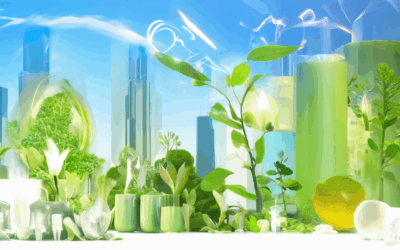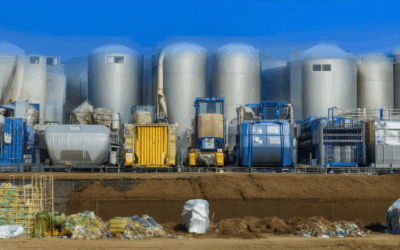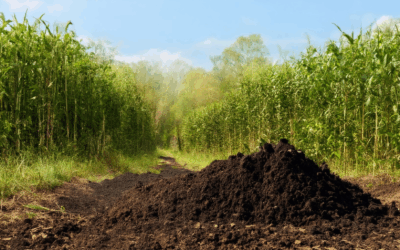As the world grapples with the growing challenge of waste management, innovative solutions have emerged to transform discarded materials into valuable resources. One such groundbreaking approach is the integration of waste-to-biochar technology, a process that converts organic waste into a highly porous carbon material known as biochar. This remarkable innovation not only addresses environmental concerns but also offers promising solutions for wastewater treatment, making it a focal point of modern sustainable practices.
Key Takeaways
– Biochar’s Dual Role: While biochar offers benefits like improved soil health and carbon sequestration, it also poses risks such as contamination and environmental impact when improperly produced or applied.
– Wastewater Treatment Innovation: Advanced waste-to-biochar technology is emerging as a sustainable solution for wastewater treatment, addressing both environmental and resource challenges.
– Production Considerations: Proper production methods are crucial to ensure biochar’s safety and effectiveness, avoiding harmful contaminants and ensuring consistent quality.
– Negative Priming Effect: Biochar’s interaction with nutrients like phosphate and ammonium nitrate can reduce their effectiveness, impacting agricultural practices.
– Regulatory and Safety Gaps: Lack of robust regulations in some regions increases the risk of distributing unsafe biochar products, emphasizing the need for standardized production practices.
– Scalability and Accessibility: Innovations in biochar production make it more accessible and cost-effective, fostering its adoption in various agricultural settings.
– Balancing Benefits and Risks: Farmers and gardeners must weigh biochar’s advantages against potential downsides, such as pH imbalance and nutrient imbalances, to achieve optimal results.

How is Biochar Produced from Waste?
Biochar is produced through a process called pyrolysis, which involves heating organic waste materials in a controlled environment to create a carbon-rich substance. Here’s a detailed overview of the process:
- Material Collection and Preparation: Start by gathering organic waste materials such as agricultural residues, manure, leaves, or even municipal waste. These materials are rich in carbon and nitrogen, making them ideal for biochar production.
- Drying the Waste: Remove moisture from the waste to ensure efficient pyrolysis. Wet materials can hinder the process and affect the final product.
- Shaping the Material: Form the prepared waste into shapes like briquettes or pellets to facilitate uniform heating during the pyrolysis process.
- Pyrolysis Process: Heat the shaped material in a closed container with minimal oxygen present. The temperature typically ranges between 300°C to 700°C, depending on the desired product. Lower temperatures may produce biochar, while higher temperatures can result in other byproducts like carbon monoxide (CO) or carbon dioxide (CO₂).
- Controlled Environment: Maintain a controlled environment to ensure the waste decomposes into biochar rather than combusting completely. Oxygen levels are kept low to suppress combustion and promote decomposition.
- Process Duration: Allow the material to decompose for several hours to fully convert it into biochar. The exact duration depends on the type of waste and desired outcome.
- Cooling the Biochar: After pyrolysis, quickly cool the biochar to prevent further reactions and ensure the carbon remains stable and effective as a soil amendment.
- Storage: Store the biochar in an airtight container to preserve its properties and prevent contamination.
The quality and efficiency of biochar production depend on factors such as the type of waste used, the pyrolysis temperature, and the control of the process. Proper preparation and monitoring are essential to achieving high-quality biochar that can be effectively utilized in various applications, such as improving soil fertility or reducing greenhouse gas emissions.
Why is biochar controversial?
Biochar has emerged as a promising solution for addressing climate change and enhancing soil health, but its adoption faces significant controversy due to various factors:
- Technical Concerns: The process of producing biochar, known as pyrolysis, involves high temperatures and specific conditions. Critics argue that the technology is still unproven and may not consistently produce high-quality biochar. There are also concerns about potential emissions of harmful substances during the process.
- Environmental Impact: While biochar is marketed as an eco-friendly alternative, its production requires energy and resources. Critics worry that the environmental costs of producing biochar could outweigh its benefits, particularly if done on an industrial scale without sustainable practices.
- Regulatory Gaps: The lack of standardized regulations for biochar production and use has led to variability in product quality. This uncertainty makes it difficult for policymakers and consumers to trust biochar as a reliable solution.
- Economic Disruption: Biochar production could potentially disrupt existing industries, such as agriculture and waste management, by providing an alternative to conventional practices. This disruption could lead to economic instability for established players in these sectors.
- Carbon Sequestration Effectiveness: Although biochar is claimed to sequester carbon, some scientists question its efficiency compared to other carbon sequestration methods. This doubt casts uncertainty on its ability to make a meaningful impact on climate change.
- Societal and Political Factors: Biochar’s promotion often aligns with broader sustainability goals, but resistance can arise from political or economic interests that oppose changes in land use or resource allocation. Additionally, there are concerns about biochar production being dominated by large corporations, potentially excluding smaller-scale farmers and local businesses.
Despite these controversies, biochar offers a unique opportunity to address environmental challenges. Its proponents argue that further research and regulation could mitigate many of the current concerns, making biochar a viable component of sustainable practices. However, until these issues are resolved, biochar’s adoption remains a contentious topic in both scientific and policy circles.

What Technology Does Biochar Now Use?
Biochar Now utilizes a cutting-edge kiln-based technology to produce its high-quality biochar. At the core of their process is a custom-designed, patented slow-pyrolysis kiln, engineered to deliver consistent and reliable results. These kilns feature advanced multi-zone combustion systems, optimized airflow, and a negative-pressure setup to enhance the pyrolysis process.
The technology incorporates a recipe-driven control system, allowing precise adjustments based on varying feedstock compositions. This ensures superior biochar production with minimal emissions, contributing to a more sustainable and eco-friendly process compared to traditional methods.
Biochar Now’s commitment to innovation extends beyond just the equipment. Their approach supports large-scale, continuous production, making it ideal for industrial applications. By focusing on sustainability and carbon sequestration, they aim to play a significant role in reducing environmental impact and combating climate change.
- Advanced Kiln Technology: Custom-designed, patented slow-pyrolysis kilns with multi-zone combustion and controlled airflow.
- Efficient Process: Recipe-driven control system minimizes emissions and ensures consistent biochar quality.
- Sustainability Focus: Designed to support large-scale production and contribute to carbon sequestration efforts.
For more details on their technology and products, visit Pyrolysium .

Drawbacks of Biochar
- Potential Contamination: Biochar may contain harmful substances such as dioxins, furans, chlorinated hydrocarbons, and polycyclic aromatic hydrocarbons (PAHs). These contaminants can pose serious health risks if ingested or inhaled.
- Environmental Impact: While biochar is often praised for its carbon-sequestration benefits, improper production or application can lead to negative environmental effects. Excessive use might cause drainage issues or disrupt soil health if not managed properly.
- Handling and Disposal Challenges: Biochar can be heavy and difficult to handle, leading to potential messiness during application. Improper disposal can also contribute to environmental contamination.
- Regulatory Gaps: In some regions, the production and sale of biochar may lack sufficient regulation, increasing the risk of distributing contaminated products that could harm users or the environment.
About Biochar
Biochar is a carbon-rich material produced through the process of pyrolysis, which involves heating organic matter in low-oxygen environments. Derived from biomass such as wood, manure, or crop residues, biochar serves as a stable form of carbon that can remain in the soil for centuries.
The Truth About Biochar
1. **Soil Improvement**: Biochar enhances soil health by increasing its ability to retain moisture, reduce compaction, and improve microbial activity. It also adds essential nutrients like phosphorus, potassium, and magnesium to the soil.
2. **pH Balance**: While biochar generally improves soil fertility, applying it in large quantities can temporarily raise soil pH levels. This can be beneficial for acid-sensitive plants but may require careful monitoring to avoid disrupting existing soil ecosystems.
3. **Contamination Risks**: The effectiveness of biochar depends on the quality of its production. Contaminated biochar can introduce harmful pathogens or heavy metals into the soil, so it’s crucial to source it from reputable producers.
4. **Carbon Sequestration**: One of biochar’s significant advantages is its ability to sequester carbon, thereby reducing greenhouse gas emissions and contributing to climate resilience.
5. **Practical Applications**: Biochar has been successfully integrated into farming practices to boost crop yields, improve plant resistance to pests and diseases, and enhance overall soil productivity. Farmers report better root development and nutrient uptake in plants treated with biochar.
6. **Research and Evidence**: Empirical studies have demonstrated biochar’s positive impacts on soil health and agricultural outcomes. Extensive research supports its role in sustainable land management and food security.
7. **Considerations**: Proper preparation and application are key to maximizing biochar’s benefits. Overuse can lead to unintended consequences, such as excessive pH levels or nutrient imbalances. Always consult with agricultural experts before incorporating biochar into farming practices.
8. **Cost-Effective and Scalable**: Biochar production is increasingly accessible due to advancements in technology and scalable production methods, making it a viable solution for various agricultural settings.
By understanding these aspects of biochar, farmers and gardeners can make informed decisions about its use, ensuring optimal results while protecting the environment and promoting sustainable practices.

The Negative Priming Effect of Biochar
Biochar, a carbon-rich material produced through pyrolysis, has been studied for its potential to enhance soil health and crop production. However, researchers have identified a phenomenon known as the “negative priming effect” of biochar, which can influence agricultural practices and soil dynamics.
The negative priming effect occurs when biochar application prior to another treatment, such as phosphate or ammonium nitrate, reduces the effectiveness of that treatment. Specifically, it impacts processes like mineralization, where nutrients become available to plants over time.
This effect varies depending on several factors:
- Incubation Time: The longer biochar is allowed to incubate in the soil, the stronger the negative priming effect becomes.
- Application Ratio: A higher ratio of biochar to the co-applied nutrient exacerbates the effect.
The mechanisms behind this phenomenon include:
- Encapsulation: Biochar can encapsulate nutrients, preventing their release and absorption by plants.
- Adsorption Protection: Biochar may adsorb certain ions, reducing their availability for plant uptake.
- Reduced Microbial Activity: Biochar can inhibit soil microorganisms, slowing nutrient cycling and mineralization.
- Soil Aggregation: Biochar can promote soil aggregation, which may physically trap nutrients and limit their access to roots.
Understanding the negative priming effect of biochar is crucial for farmers and gardeners who aim to optimize nutrient use and soil health. While biochar offers numerous benefits, its interaction with other inputs requires careful consideration to maximize agricultural productivity.




0 Comments